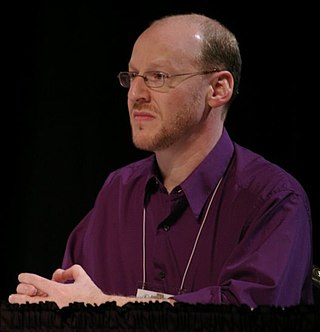Related Research Articles

The International Astronomical Union is a non-governmental organisation with the objective of advancing astronomy in all aspects, including promoting astronomical research, outreach, education, and development through global cooperation. It was founded in 1919 and is based in Paris, France.

The Astronomical Society of the Pacific (ASP) is an American scientific and educational organization, founded in San Francisco on February 7, 1889, immediately following the solar eclipse of January 1, 1889. Its name derives from its origins on the Pacific Coast, but today it has members all over the country and the world. It has the legal status of a nonprofit organization.

Philip Cary Plait, also known as The Bad Astronomer, is an American astronomer, skeptic, and popular science blogger. Plait has worked as part of the Hubble Space Telescope team, images and spectra of astronomical objects, as well as engaging in public outreach advocacy for NASA missions. He has written three books, Bad Astronomy, Death from the Skies, and Under Alien Skies. He has also appeared in several science documentaries, including How the Universe Works on the Discovery Channel. From August 2008 through 2009, he served as president of the James Randi Educational Foundation. Additionally, he wrote and hosted episodes of Crash Course Astronomy, which aired its last episode in 2016.

The Kopernik Observatory & Science Center (KOSC), is a public observatory in Vestal, New York opened to the public on 16 June 1974 by the Kopernik Society of Broome County to commemorate the 500th anniversary of the birth of the astronomer Nicolaus Copernicus in 1973. Its mission is to offer hands-on investigations and outreach programs for educating all ages about astronomy and science using advanced optical telescopes, computers and other tools. It is the first science laboratory facility in New York State designed for K-12 teachers, students and their families, and has been one of the best-sited and best equipped public observatories in the Northeast United States for nearly the last 40 years.

Gamma Ursae Minoris, also named Pherkad, is a star in the northern constellation of Ursa Minor. Together with Beta Ursae Minoris (Kochab), it forms the end of the dipper pan of the "Little Dipper", which is an asterism forming the tail of the bear. Based upon parallax measurements obtained during the Hipparcos mission, it is approximately 487 light-years from the Sun.

CP Lacertae was a nova, which lit up on June 18, 1936 in the constellation Lacerta. It was discovered independently by several observers including Leslie Peltier in the US, E. Loreta in Italy, and Kazuaki Gomi, a Japanese barber who discovered the nova during the 19 June 1936 total solar eclipse.
Doris Daou is a Lebanese-born Canadian-American astronomer who was formerly the Director for Education and Public Outreach of the NASA Lunar Science Institute and the associate director of the NASA Solar System Exploration Research Virtual Institute (SSERVI), and is currently the program contact for NASA's "Small Innovative Missions for Planetary Exploration (SIMPLEx)".
Stephen J. Edberg is a scientist at the Jet Propulsion Laboratory. He is perhaps best known for creating collaborative efforts between amateur and professional astronomers. A professional astronomer since 1970, Edberg still considers himself to be an active amateur astronomer as well and is an active astronomical observer, photographer, and telescope maker. He presently serves as staff astronomer for the Solar System Exploration website posted by NASA Headquarters and staff scientist for Earth science communication and for Exoplanet Exploration communication.

NGC 2867 is an elliptical Type II planetary nebula in the southern constellation of Carina, just over a degree to the NNW of the star Iota Carinae. It was discovered by John Herschel on April 1, 1834. Herschel initially thought he might have found a new planet, but on the following night he checked again and discovered it had not moved. The nebula is located at a distance of 7,270 light-years from the Sun.
Pamela L. Gay is an American astronomer, educator, podcaster, and writer, best known for her work in astronomical podcasting and citizen science astronomy projects. She is a senior education and communication specialist and senior scientist for the Planetary Science Institute. Her research interests include analysis of astronomy data, as well as examination of the impact of citizen science initiatives. Gay has also appeared as herself in various television documentary series.

NGC 2899 is a planetary nebula in the southern constellation of Vela. It was discovered by English astronomer John Herschel on February 27, 1835. This nebula can be viewed with a moderate-sized amateur telescope, but requires a larger telescope to resolve details. NGC 2899 is located at a distance of 3,350 ± 670 light-years (1,026 ± 205 pc) from the Sun and 25,894 ± 3 light-years (7,939 ± 1 pc) from the Galactic Center.

Macarthur Astronomy Forum is a monthly public forum organised by Macarthur Astronomical Society, providing leading national and international professional astronomers with a platform to address the Forum on topics of astronomical interest; also providing members of the Society and the general public with opportunities to learn and ask questions.

Globe at Night is an international scientific research program that crowdsources measurements of light pollution in the night sky. At set time periods within each year, the project asks people to count the number of stars that they can see from their location and report it to the project's website. The coordinating researchers compile this information to produce a public, freely available map of global light pollution. By September 2011, almost 70,000 measurements had been made. The use of data collected by the public makes the program an example of citizen science. Globe at Night began as a NASA educational program in the US organized by the NOAO, and was expanded internationally during the 2009 International Year of Astronomy; it is an offshoot of the GLOBE Program, which focuses on school-based science education.
Robert J. Nemiroff is an Astrophysicist and Professor of Physics at Michigan Technological University. He received his Ph.D. from the University of Pennsylvania in Astronomy and Astrophysics in 1987 and his B.S. from Lehigh University in Engineering Physics in 1982. He is an active researcher with interests that include gamma-ray bursts, gravitational lensing, and cosmology, and is the cofounder and coeditor of Astronomy Picture of the Day (APOD), the home page of which receives over a million hits a day, approximately 20% of nasa.gov traffic. He is married and has one daughter.

QS Telescopii is a faint, well-studied binary star system in the southern constellation Telescopium. It is composed of a white dwarf and main sequence donor star, locked into a close, circular orbit facing one another. Known as polars, material from the donor star does not form an accretion disk around the white dwarf, but rather streams directly onto it. This is due to the presence of the white dwarf's strong magnetic field. The pair undergo frequent shifts between a high and low accretion states, and it shifts between single and double accretion poles. The main pole is partially self-eclipsing.

Jacob Noel-Storr is an astrophysics researcher and science education and outreach specialist researcher, Presently the lecturer for practical astronomy and X-Lab-PAM team leader at the University of Groningen and president of InsightSTEM, Inc. He was an assistant research professor and director of the Insight Lab for Science Outreach and Learning Research at Rochester Institute of Technology, and assistant staff scientist in the Steward Observatory and Flandrau Science Center at the University of Arizona. He is known for contributions to the study of Active Galactic Nuclei / Supermassive Black Holes, as well as science / astronomy education and outreach.

Amanda Elaine Bauer is an American professional astronomer and science communicator. She is the Deputy Director and Head of Science and Education at Yerkes Observatory in Williams Bay, Wisconsin. She was previously based in Tucson, Arizona, working as Head of Education and Public Outreach at the Large Synoptic Survey Telescope. From 2013 to 2016 she was a Research Astronomer at the Australian Astronomical Observatory (AAO). Her principal field of research concerns how galaxies form, how they create new stars, and particularly why they suddenly stop creating new stars.
Nancy Cottrell Maryboy is a Cherokee and Navajo Indigenous science expert and educator. Maryboy is the president of the Indigenous Education Institute, an organization she founded in 1995 to apply traditional Indigenous knowledge to contemporary settings. Much of her work has focused on Indigenous astronomy and she has written several books on Navajo astronomy.

QQ Vulpeculae is a cataclysmic variable binary star system in the northern constellation of Vulpecula, abbreviated QQ Vul. It has a brightness that fluctuates around an apparent visual magnitude of 14.7, which is too faint to be viewed with the naked eye. The distance to this system is approximately 981 light years based on parallax measurements.
References
- ↑ Santascoy, S. J. (September 2011). Jensen, Joseph B.; Manning, James G.; Gibbs, Michael G. (eds.). Wild about Social Media and Technology?. Earth and Space Science: Making Connections in Education and Public Outreach. Proceedings of a conference held at the University of Colorado, Boulder, Colorado, USA 31 July-4 August 2010. San Francisco: Astronomical Society of the Pacific. p. 147. Bibcode:2011ASPC..443..147S.
- ↑ Ames, Z.; et al. (August 2010). Barnes, Jonathan; et al. (eds.). The Next Generation of NASA Night Sky Network: A Searchable Nationwide Database of Astronomy Events. Science Education and Outreach: Forging a Path to the Future. Proceedings of a conference held September 12-16, 2009 in Millbrae, California, USA. p. 456. Bibcode:2010ASPC..431..456A.